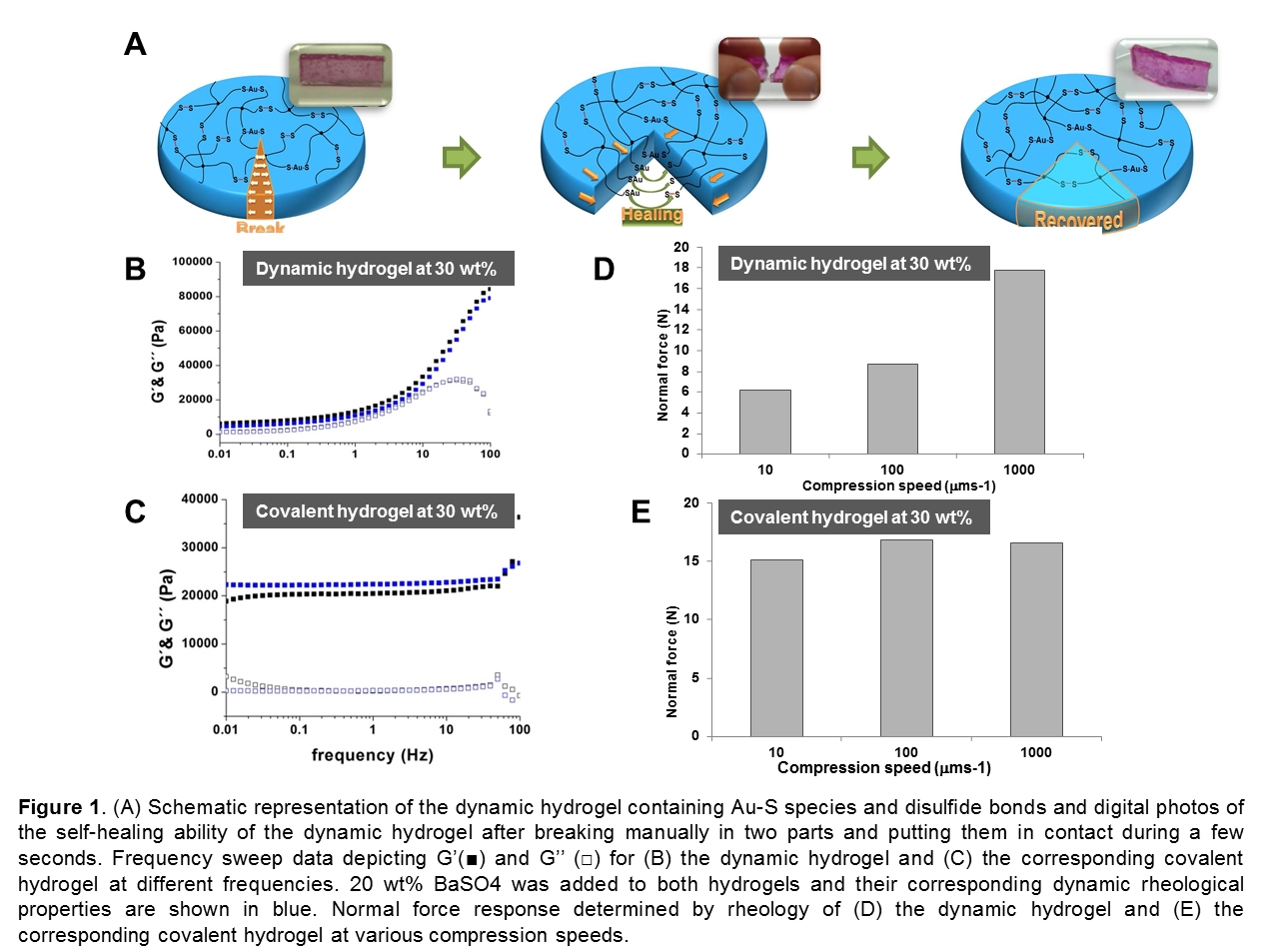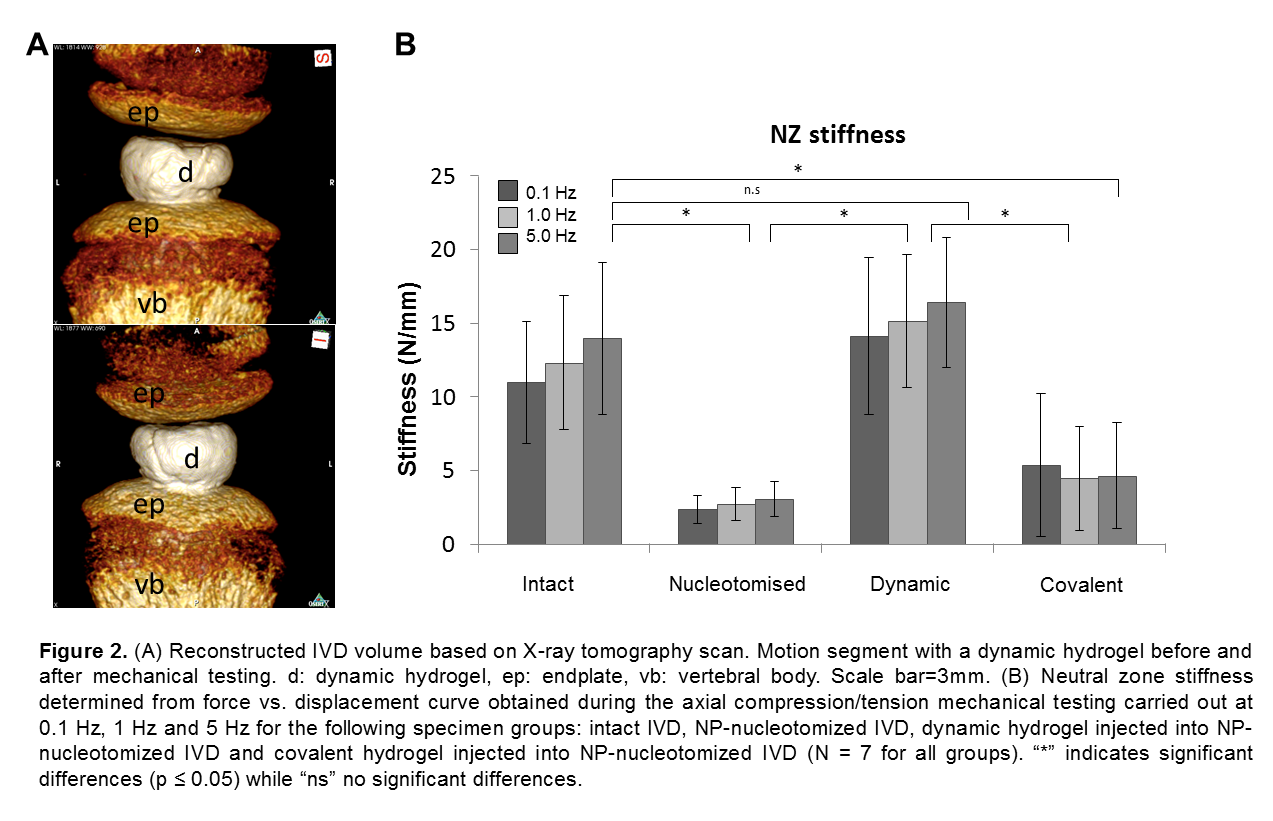Introduction: This study propose a novel dynamic hydrogel based on Gold-thiolate/disulfide (Au-S/SS) exchange with unique features like self-healing and shear thickening[1],[2] as an efficient biomaterial for nucleus pulposus (NP) replacement. To do so, the rheological behaviour of the dynamic hydrogel and the corresponding covalent hydrogel were compared and mechanical test coupled with imaging techniques were performed on partially nucleotomized IVDs restored with both hydrogels (n=28).
Materials and Methods: Hydrogel preparation: 30% w/v thiol terminated 4-arm poly(ethylene glycol) was mixed with HAuCl4 in the presence of 20 wt.% of barium sulfate as contrast agent. For covalent hydrogels, a 30% w/v thiol terminated 4-arm PEG was reacted with poly(ethylene glycol) diacrylate (PEGDA). Rheological characterization: Shear storage and loss moduli (G' and G'', respectively) were obtained at constant deformation (1%) with increasing frequency (from 0.01 to 50 Hz). Compression test consisted of 5 sinusoidal cycles at 10, 100 and 1000 mm/sec. Hydrogel delivery to spine motion segments: Bovine tails (n=28) were isolated and a partial nucleotomy (5 mm diameter) was made through the center of the upper vertebra. A preformed dynamic or covalent hydrogel (~150 µl) was injected. Computed tomography imaging: Hydrogels were tracked before and after mechanical test by high-resolution peripheral quantitative tomography (XtremeCT, Scanco Medical) (resolution: 82 µm, 60 kVp, integration time: 200 ms). Biomechanical testing: The testing protocol consisted of 5 sinusoidal cycles from 60 N compression to 45 N tension performed successively at 0.1, 1 and 5 Hz, followed by a creep test at -30 N for 1 hr. The fifth cycle at each frequency was used for data analysis.
Results and Discussion: Rehological properties of the dynamic hydrogel exhibited frequency dependent stifness with an increase of the dynamic moduli with frequency (4500 Pa to 78000 Pa). This peculiar mechanical behavior was attributed to the permanent exchange between Au-S species and disulfide bonds which is readily occurring in water at physiological conditions.[2] In contrast, the corresponding covalent hydrogel exhibited constant values of G´and G´´ (Figure 1b-c). A similar behavior was observed under unconfined compression (Figure 1 d-e).

X-ray imaging demonstrated that the cavity was perfectly filled after and before mechanical testing (Figure 2 a). NZ stiffness value for the NP-nucleotomized IVD group decreased by 85% compared to the intact IVD group, while for dynamic hydrogel its value did not differ more than 17.33%. Covalently cross-linked hydrogel did not appear to affect positively the mechanical properties of the nucleotomized IVD. Interestingly, the NZ stiffness values showed a slight increase with increasing frequencies for both, the intact IVD and the group of IVD containing the dynamic hydrogel only demonstrated that the frequency-dependent properties allowed the original mechanical properties of the native NP to be recovered. On the contrary, this trend was not observed for NP-nucleotomized IVD and the specimen containing the covalently cross-linked hydrogel.

Conclusion: In this work, we have shown a novel dynamic hydrogel with self-healing ability and frequency-dependent as a potential biomaterial suitable as NP replacement to treat IVD degeneration.
To the best of our knowledge, this material represents the first example of frequency-dependent dynamic hydrogel into motion segments that increases the stiffness of the native disc and thus represents convincing potential alternative as NP substitute for IVD repair.
The authors acknowledge COST Action STSM (MP1005-NAMABIO) and SNF international short visit grant (IZKOZ3-161639).
References:
[1] P. Casuso, A. Pérez-San Vicente, H. Iribar, A. Gutiérrez-Rivera, A. Izeta, I. Loinaz, G. Cabañero, H.-J. Grande, I. Odriozola, D. Dupin., "Aurophilically cross-linked "dynamic" hydrogels mimicking healthy synovial fluid properties", Chem Com., 2014, 50, 15199-15201.
[2] Casuso, P., Odriozola, I., Pérez-San Vicente, A., Loinaz, I., ... & Dupin, D. (2015). "Injectable and self-healing dynamic hydrogel based on Metal (I)-Thiolate/Disulfide Exchange with tuneable mechanical properties". Biomacromolecules, Accepted.